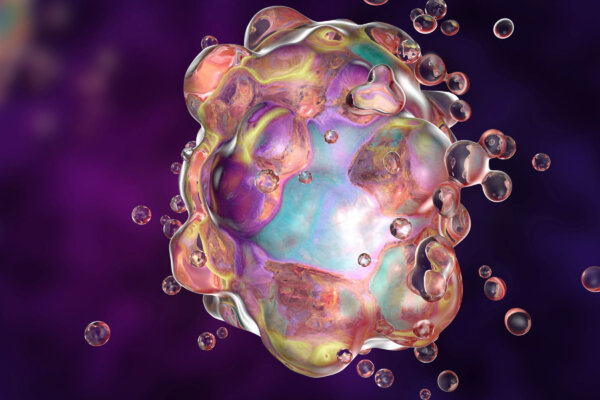Research Suggests Unusual Form of Cell Death Causes Severe COVID-19 Lung Damage
Ferroptosis may be the driving force behind severe pulmonary manifestations of COVID-19.
SARS-CoV-2 infection may cause severe pulmonary conditions such as pneumonia, inflammation, and acute respiratory distress syndrome, but until now, researchers have not understood the driving force behind lung damage caused by COVID-19.
What Is Ferroptosis?
Human cells have powerful mechanisms for maintaining survival, but when those mechanisms become impaired, lipid peroxides—generated through normal metabolic activities—can accumulate to toxic levels, damage cell membranes, and kill cells through ferroptosis.
Since proposing the concept, Mr. Stockwell’s lab has demonstrated that ferroptosis can occur in healthy contexts as part of the body’s normal processes. For example, cell death can remove cells infected with SARS-CoV-2, inhibiting the replication and spread of the virus or counteract diseases like cancer, which involves rapid cell growth.
On the other hand, ferroptosis can be destructive, attacking healthy cells in patients with neurodegenerative diseases or causing severe manifestations of COVID-19 and possibly even long COVID.
The ability to stop ferroptosis could pave the way for treatments that improve COVID-19 outcomes, the paper’s findings suggest.
The Study
Researchers obtained lung tissue samples from the autopsies of patients who died of respiratory failure caused by severe COVID-19, including those with and without acute lung injury (ALI). Samples were also collected from patients who had mild COVID-19 and recovered.
Control samples were obtained from pre-pandemic healthy patients who showed no signs of SARS-CoV-2 infection or lung damage. Samples from autopsies with ALI and without a history of SARS-CoV-2 infection were also analyzed. Additionally, serum ferritin records were obtained, as serum ferritin is elevated in critically ill COVID-19 patients, correlates with disease severity, and supplies the iron that drives ferroptosis. Ferritin is a protein found inside cells that stores iron and allows the body to use it when needed.
The researchers analyzed cell death markers on COVID-19 lung tissue samples obtained from the autopsies and found “distinct molecular features of ferroptosis” in severe lung pathologies. Moreover, samples revealed elevated ferroptosis markers, including iron dysregulation, lipid peroxidation, elevated lysophospholipids, and depletion in polyunsaturated fatty acyl tails (PL-PUFAs).
PUFAs, or polyunsaturated fatty acids, while essential for cell membranes and immune regulation, are highly unstable and inflammatory. Due to their sensitivity to oxygen, PUFAs can be oxidized by free radicals and broken down into toxic derivatives.
In a secondary analysis, Syrian hamsters were intentionally inoculated with the same strain of SARS-CoV-2 found in patient samples. Researchers analyzed lung samples and found that ferroptosis occurred at an early stage of lung disease and accompanied disease progression.
To confirm their findings were caused by ferroptosis, the researchers measured cell death markers associated with other forms of cell death. They did not detect an increase in these markers in any lung samples, indicating that ferroptosis was the major cell death mechanism detected in fatal COVID-19 lung samples.
“Altogether, these data suggest a strong correlation between ferroptosis and COVID-19 lung pathology, and ferroptosis inhibition may serve as adjuvant therapy to reduce lung injury,” the authors wrote.






